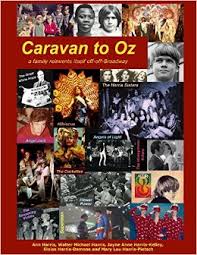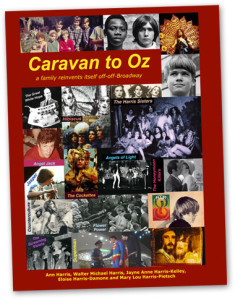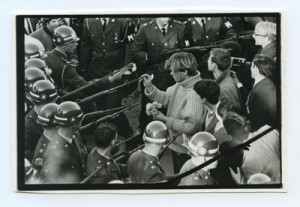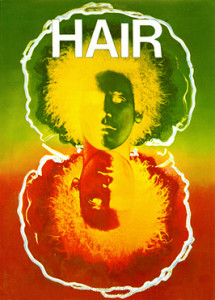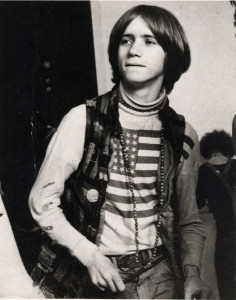On July 14, 2015, T magazine assembled some of the artists, writers, performers, musicians and intellectuals who defined New York’s inimitable and electrifying cultural scene of the late 1970s and early ’80s. Happy to say we were a seminal part of that scene among many, many other influential creative people living and no longer with us who do not appear in this photograph or article. Click on the link above the picture to read about the remarkable times.
Category Archives: Hair – The Musical
If Happy Little Bluebirds Fly Beyond The Rainbow, So Can The Harris Family! – Andrew Martin
The review below was written by our talented friend performer, writer, radio personality Andrew Martin:
Anyone who has ever availed themselves of the Off-Off-Broadway experience in New York City, whether as a performer, a crew member or simply “one of those little people out there in the dark,” will truly sink their literary teeth into Caravan to Oz, a splendid history of one family’s journey into a most exciting period in the American theater in the Big Apple. Anyone who hasn’t ever availed themselves of the Off-Off-Broadway experience in New York City, whether as a performer, a crew member or simply “one of those little people out there in the dark,” will truly sink their literary teeth into the book all the same. And in any case, this two-hundred-and-seventy page tome laden with stunning photography, emerges as a wondrous history lesson even to those not necessarily theater-oriented. To be succinct, it’s nearly impossible to put down once begun reading. The book bears vague similarities to Edie, the smash recounting of Warhol superstar Edie Sedgwick, except that in this case the story is actually told by the subjects in question, along with additional input by such legends of the Off-Off-Broadway scene and the cultural world at large as Tim Robbins, Bob Heide, Robert Patrick, Crystal Field, Mike Figgis, Mark Lancaster, Ritsaert ten Cate, and the late Ellen Stewart.
The caravan begins its initial drive down life’s highway in the Westchester, New York enclave of Bronxville, where actor-writers George Edgerly Harris II (hereafter referred to as George Sr) and his wife Ann launched a family of six eventual children, namely and in order George Edgerly Harris III (hereafter referred to as G3), Walter Michael Harris, Frederic Joseph Harris, Jayne Ann Harris (today Harris-Kelley), Eloise Alice Harris (today Harris-Damone) and Mary Lucille Harris, hereafter referred to as Mary Lou. After the family relocated to Belleaire, a suburb of Clearwater in Florida, and spent several years there in which all six of the children proved themselves extremely adept at both performance and self-producing various extravaganzas, the family once again headed north and took up residence on the Lower East Side, slowly assimilating themselves into the world of Off-Off-Broadway which had already begun coming into its own ten or more years earlier with the advent of LaMaMa Experimental Theater Company, the Living Theater, and the Caffe Cino. By the late 1960s, Walter Michael (not merely an actor-singer but a very impressive and self-taught musician) had established himself as the youngest original cast member of the hit musical Hair on Broadway, while George Sr took a role in The Great White Hope and subsequently took the show on the road, and mother Ann assumed a featured part in the classic horror film The Honeymoon Killers, alongside Shirley Stoler and Tony LoBianco. G3, meanwhile, trotted off to San Francisco to find his own path and, aside from being reportedly the first person to stick flowers into the gun barrels of the police during the Summer of Love in Haight-Ashbury while living on a commune, also began exploring drag artistry under the name Hibiscus as a founding member of the pioneering troupe The Cockettes. Upon his self-imposed termination in Hair, Walter Michael also ventured to Northern California to join his big brother but opted for a more spiritual path, ultimately becoming a monk of the Holy Order of MANS (although he did eventually return to the theatrical fold after a fashion). Once reborn as the theater company The Angels of Light, the girls of the family along with their mother settled into a happy existence as literally the First Family of Off-Off-Broadway besides appearances on a triumphant tour of several European countries.
The story also has some disturbing twists and turns. Hibiscus ended up as one of the earliest-known victims to succumb to the AIDS crisis. It’s also notable that brother Fred offers no input to the book whatsoever, leaving a reader wondering exactly what his side to the story might be. The Harris Sisters, however, continued to find fame as a trio within the cabaret club spectrum during the 1980s and 1990s (occasionally making appearances with the renowned downtown actor-singer Bobby Reed), and the entire book is interlaced with lyrics written by mother Ann for such shows as The Sheep and the Cheapskate, There Is Method In Their Madness, and Sky High. It’s almost a little too much to take in upon just one reading, to realize exactly how incredible this superb family of eight managed to accomplish in one lifetime together. But by the last page, one can’t help but feel a sense of peace, as well as the hope that anything in life is truly possible given the right brand of dedication and talent.
Caravan to Oz is available by ordering here. Do yourselves a favor and grab a copy.
What people are saying about Caravan to Oz – D.S. Ripley
And it’s all, or mostly, there, told with humor, love, grace and honesty. From the early “Let’s put on a show!” days in Florida, to the risky transplanting of the whole tribe to New York, to the beginnings of the Theatre for the New City, the family-written and produced shows at La MaMa ETC, the groundbreaking and culture-changing phenomenon of “Hair”, to the founding of the Cockettes in San Francisco, the journeys through Europe, a monastery, and Bay Area communes, to the shattering new reality of the AIDS epidemic and the maturity and mellowing of seasoned performers with an amazing range of talents and accomplishments. They renewed themselves with each success, setback, and new inspiration, began new families and, through it all, retained their devotion to each other. The Harrises were, and are, in and of their times in a way that very few, if any, other families could have been. It’s a remarkable ride through a time that must have looked very different on the inside of the magic mirror, as they were. I found this ride to be enriching as I looked back over the years they describe, and saw those times from a fresh and exhilarating perspective.
Brothers Against The War Machine
by Walter Michael Harris
In the fall of 1967, with the war in Vietnam raging, a large scale antiwar demonstration was organized at the Pentagon. Many photojournalists were on hand, including Bernie Boston, who took a photo of my brother, George Harris III, age 18, inserting flowers into the rifle barrels of National Guard soldiers in a tense confrontation.
Bernie Boston told Curio Magazine interviewer Alice Ashe in 2005:
“I saw the troops march down into the sea of people, and I was ready for it. One soldier lost his rifle. Another lost his helmet. The rest had their guns pointed out into the crowd, when all of a sudden a young hippie stepped out in front of the action with a bunch of flowers in his left hand. With his right hand he began placing the flowers into the barrels of the soldiers’ guns. He came out of nowhere, and it took me years to find out who he was . . . his name was Harris.”
Boston’s iconic image of my brother George, answering guns with flowers, remains a metaphor for the message of the 1960s youth counterculture movement – that love can overcome political tyranny, unite the human family, break the war machine, and bring peace to the world.
Three months later, at age 16, I was cast in the rock musical HAIR as it was preparing to open on Broadway. HAIR has a reputation as a “hippie musical” but, in fact, it was (and is) a powerful anti-war statement. The show was an overnight sensation, broadcasting the hopes and dreams of the youth counterculture, and an earnest plea to end the war.
Boys from my New York City neighborhood were drafted, went to Vietnam and returned injured, or never came back. Inspired by my brother meeting guns with flowers, I poured my whole self into making my performance in HAIR a deeply personal statement against the Vietnam War. I believe the show’s many first-run productions around the world played a part in ending the war. In modern HAIR productions my brother’s courageous act of protest is reenacted.
Our full story is in the new memoir, Caravan to Oz: a family reinvents itself off-off-Broadway.
To order the book, CLICK HERE.
Photo credits for this blog:
“Flower Power” – Bernie Boston/RIT Archive Collections/Rochester Institute of Technology
HAIR Logo – courtesy Michael Butler
Walter Michael Harris – Youngest Cast Member Of Hair on Broadway
By Ann Harris and Walter Michael Harris
Ann: In autumn 1967 Walter was sixteen and attending the High School of Music and Art. A friend of his asked him to play piano for his audition for HAIR. Walter said “yes” and when the audition ended, Tom O’Horgan, the director, asked if he would like to audition too. So Walt did, and got the part. It was a happy day. Walter was the youngest member of the original Broadway cast. HAIR rehearsed at Ukrainian Hall one-half block from our Ninth Street apartment, and opened April 29 the following year.
Walter Michael: My interest in education was waning. Exhausted from so much after-school theater, I was caught between adolescence and adulthood and surrounded by a seismic cultural shift. The youth counterculture movement was forcing the country to reevaluate its values and priorities.
Although busier than ever as a working actor and musician I was unsure of my place in the world. . My year with HAIR (April 1968 – March 1969) yanked me out of my insecurity and self-doubt and thrust me into the vortex of the youth counterculture, political awareness and a cathartic theatrical experience that changed everything.
The company included the co-authors, Gerome Ragni and James Rado, in the lead roles of Berger and Claude. A handful of actors from the initial Public Theater production were held over. New faces included La MaMa players like Jon Kramer and myself; plus amateurs, pros and people off the street. The chemistry between the authors, the composer and band, the cast and designers, our courageous producer Michael Butler and La MaMa director Tom O’Horgan, produced a hit musical that connected with audiences and critics. Clive Barnes, writing for the New York Times, declared that HAIR was “the first Broadway musical in some time to have the authentic voice of today rather than the day before yesterday.”
HAIR was a smash hit. The cast enjoyed delivering and living HAIR’s powerful anti-war message eight times a week, set to Galt MacDermot’s pulsating score. Shows sold out months in advance. After opening night our company knew that HAIR was more than mere entertainment. We believed it was an experience with the potential to end the Vietnam War, unite the planet and usher in the Age of Aquarius.
From the Harris family’s new memoir, Caravan to Oz: a family reinvents itself off-off-Broadway, © 2014.
Hair: The American Tribal Love-Rock Musical


